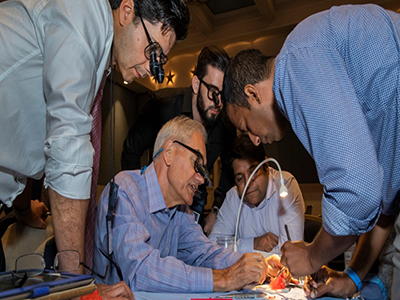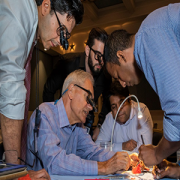Snapshot: The Sixth Scientific Meeting of the World Society for Pediatric and Congenital Heart Surgery

Dr. Richard Jonas shows surgical advancements using 3D heart models, which participants could bring back to their host institutions.
On July 22, 2018, more than 700 cardiac specialists met in Orlando, Fla. for the Sixth Scientific Meeting of the World Society for Pediatric and Congenital Heart Surgery (WSPCHS 2018).
The five-day conference hosted a mix of specialists, ranging from cardiothoracic surgeons, cardiologists and cardiac intensivists, to anesthesiologists, physician assistants and nurse practitioners, representing 49 countries and six continents.
To advance the vision of WSPCHS – that every child born with a congenital heart defect should have access to appropriate medical and surgical care – the conference was divided into eight tracks: cardiac surgery, cardiology, anesthesia, critical care, nursing, perfusion, administration and training.
Richard Jonas, M.D., outgoing president of WSPCHS and the division chief of cardiac surgery at Children’s National Health System, provided the outgoing presidential address, delivered the keynote lecture on Transposition of the Great Arteries (TGA) and guided a surgical skills lab with printed 3-D heart models.
Other speakers from Children’s National include:
- Gil Wernovsky, M.D., a cardiac critical care specialist, presented on the complex physiology of TGA, as well as long-term consequences in survivors of neonatal heart surgery, including TGA and single ventricle.
- Mary Donofrio, M.D., a cardiologist and director of the Fetal Heart Program, presented “Prenatal Diagnosis: Improving Accuracy and Planning Delivery for babies with TGA,” “Systemic Venous Abnormalities in the Fetus,” “Intervention for Fetal Lesions Causing High Output Heart Failure” and “Fetal Cardiac Care – Can We Improve Outcomes by Altering the Natural History of Disease?”
- Gerard Martin, M.D., a cardiologist and medical director of global services, presented “Is the Arterial Switch as Good as We Thought It Would Be?” and “Impact, MAPIT, NCPQIC – How and Why We Should All Embrace Quality Metrics.”
- Pranava Sinha, M.D., a cardiac surgeon, presented the abstract “Cryopreserved Valved Femoral Vein Homografts for Right Ventricular Outflow Tract Reconstruction in Infants.”
Participants left with knowledge about how to diagnose and treat complex congenital heart disease, and an understanding of the long-term consequences of surgical management into adulthood. In addition, they received training regarding standardized practice models, new strategies in telemedicine and collaborative, multi-institutional research.
“It was an amazing experience for me to bring my expertise to a conference which historically concentrated on surgical and interventional care and long-term follow-up,” says Dr. Donofrio. “The collaboration between the fetal and postnatal care teams including surgeons, interventionalists and intensive care doctors enables new strategies to be developed to care for babies with CHD before birth. Our hope is that by intervening when possible in utero and by planning for specialized care in the delivery room, we can improve outcomes for our most complex patients”.
The Johns Hopkins University School of Medicine, Florida Board of Nursing, American Academy of Nurse Practitioners National Certification Program, American Nurses Credentialing Center and the American Board of Cardiovascular Perfusion provided continuing medical credits for eligible providers.
“I was so proud to be a member of the Children’s National team at this international conference,” notes Dr. Wernovsky. “We had to the opportunity to share our experience in fetal cardiology, outpatient cardiology, cardiac critical care, cardiac nursing and cardiac surgery with a worldwide audience, including surgical trainees, senior cardiovascular surgeons and the rest of the team members necessary to optimally care for babies and children with complex CHD. In addition, members of the nursing staff shared their research about advancements in the field. It was quite a success – both for our team and for all of the participants.”



